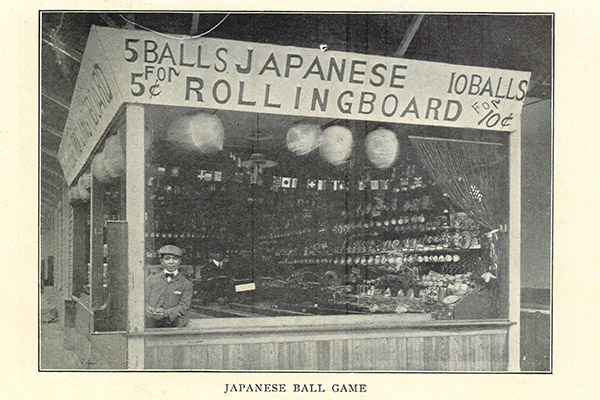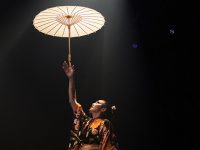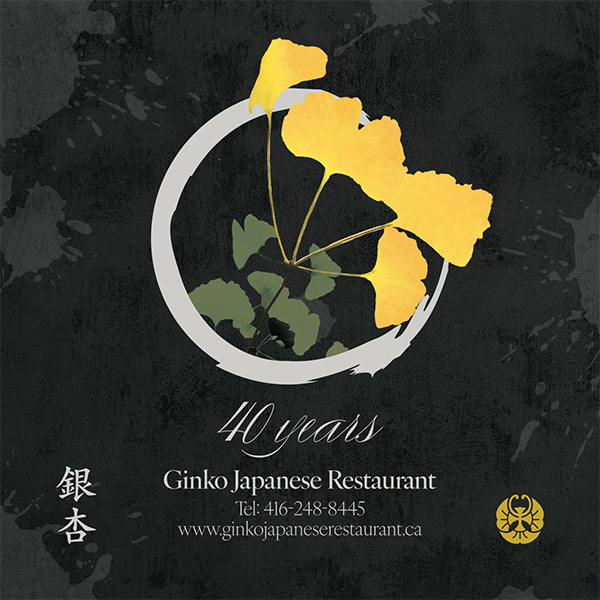A photo of a Japanese Rolling Ball game booth in Coney Island in 1904.
OTTAWA — What started for me as a pinball addiction had somehow led to poring over newspapers from 1901, trying to piece together stories of Japanese businessmen and immigrants and how they relate to a game called tamakorogashi.
Simple by modern standards, tamakorogashi (玉ころがし), or Japanese Rolling Ball in North America, might be the birthplace of modern redemption arcades. Redemption arcades—where you play a game for tickets/points to redeem for prizes—can now be traced back to 1880 Japan.
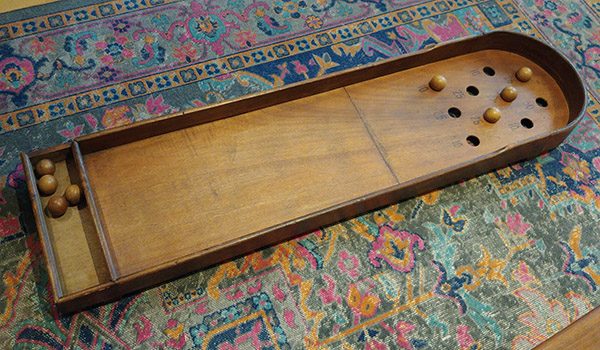
A Rolling Ball game in Caitlyn’s collection. Photo credit: Caitlyn Pascal.
As a child, I was drawn to pinball—partly because I could find free credits on machines—but also because of the exciting kinetic motion of the silver ball. This led me to 1970s machines, then 1950s, and then the era of pinball’s birth, the 1930s. I became entranced with arcades’ roots in other countries, like Britain, Germany, France, and especially Japan. Unique circumstances and innovations from each country led us to the global arcade industry, which birthed home video games: one of the most dominant forces in popular culture today.
Most interest in “arcades” begins in Japan with the epoch-defining Space Invaders of 1978. But I fell in love with Japan’s arcade industry of the 1970s and 60s, a dizzying display of electromechanical innovation. I loved the aesthetics of the pachinko machines and medal gambling halls.
While American gambling moved away from the silver balls in the 1950s, they were taking off with a fiery excitement in Japan.
My dig through the decades led me to Kazuo Sugiyama (杉山 一夫), Japan’s premier historian of pachinko. A printmaker by trade, Sugiyama has spent decades preserving and correcting Japan’s pachinko history, even converting his house into the Birth of Pachinko Museum (パチンコ誕生博物館).
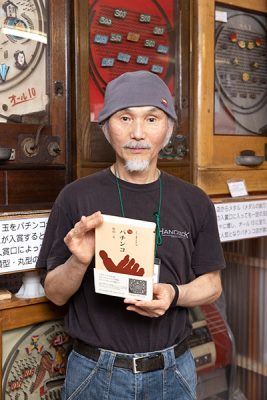
Kazuo Sugiyama with his book, Cultural History of Things and Humans: PACHINKO.
After profiling Mr. Sugiyama in a blog post, I offered some research on a few of the 1930s machines in his museum. In his 4th book, published by Hosei University Press, Cultural History of Things and Humans: PACHINKO (ものと人間の文化史 186: パチンコ), I was delighted to find my name mentioned in print. Shortly after publication, he told me of his next project, a book on tamakorogashi, and asked for my research assistance.
Japanese Rolling Ball seems to first appear in North America in 1901, as part of a cultural spectacle called “Fair Japan,” held at the Pan-American Exposition in Buffalo, New York. The game quickly spread to the midways of Atlantic City, California, and theme parks across the U.S. and Canada.
Players would roll balls up a long board with shallow pockets at one end, each marked with various point values. The game’s popularity started in Japan around 1880, and in North America, it was a hit from the 1900s until around 1930. The innovation that persisted from these games 140 years later was that your score was tallied in a ledger. You could play all season long and grow your total, exchanging points for various prizes. This model can be found in contemporary redemption arcades, with swipe cards and digital point accounts.
Imported goods were a rare treat, and the game was a way to purchase or win exotic wares and traditional Japanese crafts. Many enjoyed the game itself, with the prizes as a bonus. As some immigrants of the era wrote, many white Americans also found novelty in seeing a real Japanese person.
Japanese Rolling Ball would be a staple at amusement parks and midways for the first few decades of the 20th century, embedding itself into the popular culture. It faded fast with the rise of electric automated amusements and pinball machines, but its redemption model now dominates arcades worldwide. And it all started a century before Space Invaders was released.
If you would like more information, or have any to add, I have compiled my research online here.
You can visit Kazuo Sugiyama’s Birth Of Pachinko Museum at www.pachinko-tanjo.com and visit in person in Yokosuka when the pandemic recedes. Mr. Sugiyama’s book on tamakorogashi will be published by Hosei University next year.
***







 18 Jan 2022
18 Jan 2022
 Posted by Caitlyn Pascal
Posted by Caitlyn Pascal 